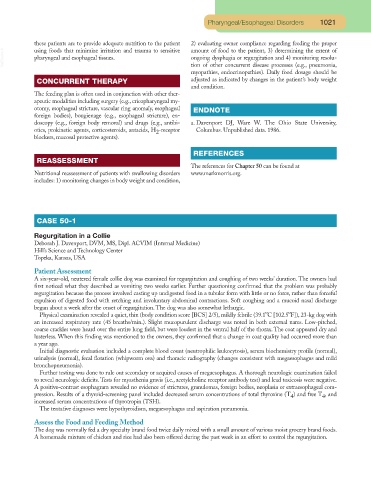Page 984 - Small Animal Clinical Nutrition 5th Edition
P. 984
Pharyngeal/Esophageal Disorders 1021
these patients are to provide adequate nutrition to the patient 2) evaluating owner compliance regarding feeding the proper
VetBooks.ir using foods that minimize irritation and trauma to sensitive amount of food to the patient, 3) determining the extent of
ongoing dysphagia or regurgitation and 4) monitoring resolu-
pharyngeal and esophageal tissues.
tion of other concurrent disease processes (e.g., pneumonia,
myopathies, endocrinopathies). Daily food dosage should be
CONCURRENT THERAPY adjusted as indicated by changes in the patient’s body weight
and condition.
The feeding plan is often used in conjunction with other ther-
apeutic modalities including surgery (e.g., cricopharyngeal my-
otomy, esophageal stricture, vascular ring anomaly, esophageal ENDNOTE
foreign bodies), bougienage (e.g., esophageal stricture), en-
doscopy (e.g., foreign body removal) and drugs (e.g., antibi- a. Davenport DJ, Ware W. The Ohio State University,
otics, prokinetic agents, corticosteroids, antacids, H -receptor Columbus. Unpublished data. 1986.
2
blockers, mucosal protective agents).
REFERENCES
REASSESSMENT
The references for Chapter 50 can be found at
Nutritional reassessment of patients with swallowing disorders www.markmorris.org.
includes: 1) monitoring changes in body weight and condition,
CASE 50-1
Regurgitation in a Collie
Deborah J. Davenport, DVM, MS, Dipl. ACVIM (Internal Medicine)
Hill’s Science and Technology Center
Topeka, Kansas, USA
Patient Assessment
A six-year-old, neutered female collie dog was examined for regurgitation and coughing of two weeks’ duration. The owners had
first noticed what they described as vomiting two weeks earlier. Further questioning confirmed that the problem was probably
regurgitation because the process involved casting up undigested food in a tubular form with little or no force, rather than forceful
expulsion of digested food with retching and involuntary abdominal contractions. Soft coughing and a mucoid nasal discharge
began about a week after the onset of regurgitation. The dog was also somewhat lethargic.
º
º
Physical examination revealed a quiet, thin (body condition score [BCS] 2/5), mildly febrile (39.1 C [102.5 F]), 23-kg dog with
an increased respiratory rate (45 breaths/min.). Slight mucopurulent discharge was noted in both external nares. Low-pitched,
coarse crackles were heard over the entire lung field, but were loudest in the ventral half of the thorax. The coat appeared dry and
lusterless. When this finding was mentioned to the owners, they confirmed that a change in coat quality had occurred more than
a year ago.
Initial diagnostic evaluation included a complete blood count (neutrophilic leukocytosis), serum biochemistry profile (normal),
urinalysis (normal), fecal flotation (whipworm ova) and thoracic radiography (changes consistent with megaesophagus and mild
bronchopneumonia).
Further testing was done to rule out secondary or acquired causes of megaesophagus. A thorough neurologic examination failed
to reveal neurologic deficits. Tests for myasthenia gravis (i.e., acetylcholine receptor antibody test) and lead toxicosis were negative.
A positive-contrast esophagram revealed no evidence of strictures, granulomas, foreign bodies, neoplasia or extraesophageal com-
pression. Results of a thyroid-screening panel included decreased serum concentrations of total thyroxine (T ) and free T , and
4 4
increased serum concentrations of thyrotropin (TSH).
The tentative diagnoses were hypothyroidism, megaesophagus and aspiration pneumonia.
Assess the Food and Feeding Method
The dog was normally fed a dry specialty brand food twice daily mixed with a small amount of various moist grocery brand foods.
A homemade mixture of chicken and rice had also been offered during the past week in an effort to control the regurgitation.

